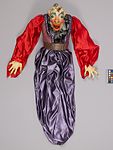marioneta (Puppet)
About this object
History of use
Ten marionettes were made especially by Jorge Cerqueira for the Museum of Anthropology collection (see #2956/293-300 & #3105/1-2). These marionetas (string puppets) represent key characters—historical heroes and gods, sultans and kings, the dangerous storm, Adamastor, and the beautiful goddess, Venus, dressed in crimson—from the Portuguese epic, The Lusiads (1572). Written by the one-eyed adventurer and beloved poet, Luís de Camões, The Lusiads tells of the Portuguese discovery of a sea route to the East. The hero of the fantastical tale is the explorer, Vasco da Gama, who is either aided or opposed on his voyage by the Roman gods: Jupiter, Bacchus, Neptune and Venus. En route, Vasco da Gama’s fleet is welcomed by the Sultan of Malindi (Kenya) and bravely battles Adamastor, the gigantic storm, before arriving in India and meeting Monsayeed, the ruler of Calcutta (now Kolkata). Setting sail again, the Portuguese explorers stop to feast on the Isle of Love and afterwards journey on through the Indian Ocean, visiting parts of Asia and Africa. This character represents Bacchus, Roman god of agriculture, wine, and fertility.
Iconographic meaning
Puppet representing Baco, or Bacchus, as a character in "Os Lusíadas" (The Lusiads). Bacchus was the god of the grape harvest, wine, and of ritual ecstasy in Roman mythology.
Physical description
String puppet (marioneta) of the character Bacchus. Face has a protruding upturned nose, thick lips, open mouth, blue-black glass balls for eyes, and blue painted brows. Ears are prominent. Cheeks, nose, ears and lips are bright orange in colour. Hair and beard are made of twisted wire. The head is attached to the body by a single string, and is controlled by a thin wooden stick located on the lower portion. The puppet’s torso is hollow with an open back, made of paper mache. The outer chest is painted purple while the inside is decoupage of black and white magazine photos of nude men and women. The arms are thick pieces of rope hidden in voluminous sleeves of red satiny fabric. Wooden hands are attached to the ends of the ropes and can be controlled by thin wooden sticks. A metal belt spans the puppet’s waist, from which hangs a full, purple vinyl skirt, closed at the bottom.
